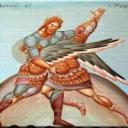Yahoo Answers is shutting down on May 4th, 2021 (Eastern Time) and beginning April 20th, 2021 (Eastern Time) the Yahoo Answers website will be in read-only mode. There will be no changes to other Yahoo properties or services, or your Yahoo account. You can find more information about the Yahoo Answers shutdown and how to download your data on this help page.
Trending News
for the senior guys about forms?
why do certain moves in forms repeat. Are they the same techniques, or are they entirely different? Also what was the point into repeating the moves
Yes I know to ignore KW, he did not even answer the question
Yes I know to ignore KW, he did not even answer the question
7 Answers
- pugpaws2Lv 78 years agoFavorite Answer
No matter how many times those of us that have many years more experience than KW tell him he still posts inaccurate and often incomplete answers about Kata.
Beginners are taught that kata repeats things both left and right to train both sides of the body. While that is true to some extent, it is not the most correct or only reason. While it is important to train both sides of the body no one that I have ever met does everything they practice equally well on both sides. you will always favor one side over the other for certain techniques. Those that have trained long and hard to balance both sides still never get all techniques equal on both sides.
Now techniques if balance between both sides was so important, then why is it that some techniques are done only once in a Kata and some done three times....? That should be a clue that there are other reasons for why some techniques are done on both sides while others are not. One reason (not the only one) that a technique is done three times has to do with the humans body and how it is effected when struck. Notice that in all Kata regardless of the style it comes from any technique that repeats three times always has two done with the right side and one with the left
side. This is not something that was done with no thought. It was done intentionally due to the way the technique works on an attacker. The techniques done three times teach that the technique (or rather the real intended application of it) will work on either side of the attackers body. BUT, the fact that it is done in the Kata twice using your right side indicates that sometimes (not always) doing the technique to the attacker using your right side (attacking his left side) might have a stronger effect. Now, before some people slap their palm to the forehead, consider this. The heart is not in the center of the body. It is slightly to the left side of the body. Some techniques that effect the heart will work when properly done to either side of his body, but may effect the heart a little stronger when done to the left side of his body.
So why do a technique only once? It would be easy to assume that it means that the technique only works if done on one side of the attacker. That would be a wrong assumption. There are valid reasons why something is done only once, but explaining that would be better explained in person and demonstrated. to even try to explain it here would be a waste of time.
A few Other (but far from all) clues to understanding Kata:
* Two hand rule.... Means that in every hand technique the hand appearing to be doing the technique is not all that is going on. Almost always the other hand is assisting in some way. for instance when someone punches they often pull the other hand back. This usually indicates that the pulling hand is grabbing the attacker and pulling him into the strike which also off-balances him.
The knife hand strike where both hands circle ending in what looks like a knife hand strike with the forward hand is usually really the other hand striking before the knife hand, OR the hand deflecting the attackers arm just before the knife hand strike with the forward hand.
Moves that are often called Augmented blocks (what appears to be one arm/hand helping the other to block) are not that at all. You never (or at least you should never need) to use two hands to block an attack. One hand is doing the main part of the technique while the other is doing something else that makes the strike more effective. The inside augmented block is often the back hand striking the attackers arm or side, while the forward hand strikes a different target. The spear hand thrust with the other arm bent and its hand near or touching the striking hands elbow is also doing something that is not apparent. One (but not the only) use is that the back hand deflects the incoming punch across your body and down opening the way for the forward thrusting hand to either spear hand thrust a specific point in the neck, or for it to enter under the attackers punching arm and at the end snap up striking him on the inside of his elbow using the bone in your hand that the thumb attaches to.
As you can see there are a ot of things going on that are not seen or understood by most people. That is the real value of the Kata. They teach body mechanics first. Later some students are shown advanced ways to apply their moves to do things that are more effective, yet not things that others can figure out.
Edit:
* Kata Perspective...... Kata is not always what we would do.... We should also see that some things in Kata are meant to be things done by an attacker, and our response is in the Kata too.
* Kata is not a fight against multiple attackers! It appears to be fighting one attacker after another. What is happening is the Kata shows many different possible ways you could be attacked and multiple ways that you might apply the techniques in the Kata against them.
...
Source(s): Martial arts training over 46 years, since 1967 Teaching martial arts over 39 years, since 1973 - jwbulldogsLv 78 years ago
Good question. You have gotten a few good answers.
It can be the same technique. It can be a different technique. It can be the same technique done from different sized and or angle. It kata everything done is not what it appears to be. A strike can be a strike. it can also be a defense to a strike. Also, if you are turning a doing a strike it can actually be a throw.
Kata allows you to practice and drill techniques without a partner. But later you are supposed to practice a drill the multidimensional techniques with a partner or partners. Some believe the kata is supposed to be one fight or fighting multiple attackers. That is far from the truth. Each technique is its own fight. But it can be a combination technique as Kokoro pointed out. You hit the same spot more than once to weaken it even further. But depending on what strike is being used it can be like shuto strike where with one strike you are striking to joint of the arm of the attacker as they attempt to strike then you make another shuto strike to a nerve on the jaw or neck from a 45 degree angle that you set up by striking the nerve or joint near the elbow on the first strike. It can be a trap that leads to a choke. It can be many things.
Unfortunately the ignorance of some they put down what they don't know or understand. I was taught long ago that it is better be thought a fool than to open your mouth and remove all doubt that you are the fool. When I see questions about tai chi or baguazhang or Chinese medicine I don't respond as my knowledge is very limited on the subject. There are some that have more experience in those areas and are more informed because of personal experience or research. It would be foolish of me to speak on things that I know very little about.
My suggestion to you that id you are talking about techniques from a specific kata you should ask your instructor. Hopefully you instructor understands something about bunkai.
I recall when I first began to learn pidan shodan. I asked my instructor about the last techniques done in the kata. It didn't make sense to me. If the kata was a fight why do we end the kata with a rising block. I wasn't aware that there was no blocks in karate. Thinking that it was a block was a pre primary way of thinking and understanding. Initially he responded that there are hidden techniques with the kata. He said something about bunkai, but didn't teach it to me. Later we broke down techniques within the kata. I learned that it was not a block. You never end a fight with a block. I learned several technique that this could be done. Then I got to practice using the different ones against a person. Then it made sense. Much like the leg black that I think t was Jim R mentioned. As a progressed in my training I learned that it is not a leg block. You do not use that to block a kick. It would be very difficult to block a kick doing this. But it is a good hammer fist on an elementary level. It becomes a throw at a middle school level. It is a break on another level. But you need a qualified instructor to teach these things. It is not something that you learn in a mcdojo or some kiddie karate class.
Source(s): Martial Arts since 1982 - 8 years ago
Some techniques have more than one purpose or function and so one might be employed differently in one part of a kata than in another part of that kata. Also the quality of your technique and being able to do that technique well all the time or consistently demonstrates a higher level of skill. Flaws in your technique become readily apparent when you are doing the same technique differently that is employed the same way throughout that kata.
- TomLv 58 years ago
It depends on the form and the style.
Contrary to what Keyboard Warrior states, forms or kata if done correctly allow you to practice moves that you wouldn't be able to do on people in different ways.
For instance, our higher level kata have knuckle strikes to the temple, leg breaks, one knuckle punches to the heart, and a bunch of other "nasty" techniques I can't do in competition or at an intense level with a person. But when I practice kata, I can envision fighting someone and doing the strikes. I can practice them slow to get the move down correctly, I can practice them at a medium speed to make it look "pretty" for competition if I choose, or I can do them fast as I would in a fight. In fact, when I practice, I use a mixture of all of the above which helps me develop speed, power, and accuracy.
In our Katas some moves will repeat a few times but we don't do them a massive number of times. But the times they repeat are to work both sides of the body, and to get repetitions in to get the moves down.
Source(s): 12 years of training and teaching in Uechi Ryu karate - How do you think about the answers? You can sign in to vote the answer.
- Jim RLv 78 years ago
In Okinawan/Japanese arts, the words bunkai and oyo are the keys to forms.
Without those things they are but movements. Bunkai/oyo give them much meaning.
Every movement has much bunkai, and many different oyo.
Godan bari can be used (rather poorly) to 'block' low kicks. It can also be used to break the arm of one who hits at your face.
Understanding this makes the kata very effective tools for teaching real martial art.
You need to consult a good instructor.
We can't give you anything more than general information here.
KW has posted definite bad advice here. He does not understand kata at all, so he calls it down.
KW when you experience more martial art, if you ever do, you may come to understand. As long as you think a game is reality, there is no hope you may understand. Please stop posting wrong information about forms. You are clearly immature and wrong. So study what you don't understand from one who does understand. Your teacher obviously never heard of bunkai or oyo.
Perhaps I am wrong. If so, please explain simply to me what those words mean.
Source(s): 40+ years shotokan - GeorgieLv 58 years ago
It depends from the case....
There are some moves that are supposed to be repeated, like the 3 strikes in a row...which are common in many styles' forms....The 3 strikes in a row are also practiced in drills...This is like a technique or a movement, the 3 strikes in a row and are useful for sparring as well...
Then in other cases the same pattern is done both sides....So is done first with the one side and then with the other....This is done for equal training on both sides and that is also good for balance, fitness, equal improvement in both sides, of body and technique...This is also common when you practice on a wall bag, punch bag, or the makiwara, to do the movement both sides for the same reasons.
- KokoroLv 78 years ago
that depends upon how you are interpreting the technique (or as jim said the bunkai and oyo) there are a number of reasons for using a technique three times in a row, from kyushu jitsu to grappling or striking reasons. its not a simple explanation.
in one example from kyushu it is used to weaken the particular area, every time you strike the same exact spot it gets more sensitive. this is only one example there are several others from kyushu. grappling adds even more to it.
ignore kw, he has proven he knows nothing about martial arts as well as mma. he thinks kung fu and karate are the same even. the only thing funner that his lack of knowledge is his out right lies.
i doubt kw knows what real full contact fighting is like.
kw answer me this how many of your class ended up loosing teeth, having to get stitches or with broken bones from your supposed full contact fighting?
edit:>
thanks for the thumbs down kw. but you still as usual ignore my question to you.
Source(s): 30+yrs ma






